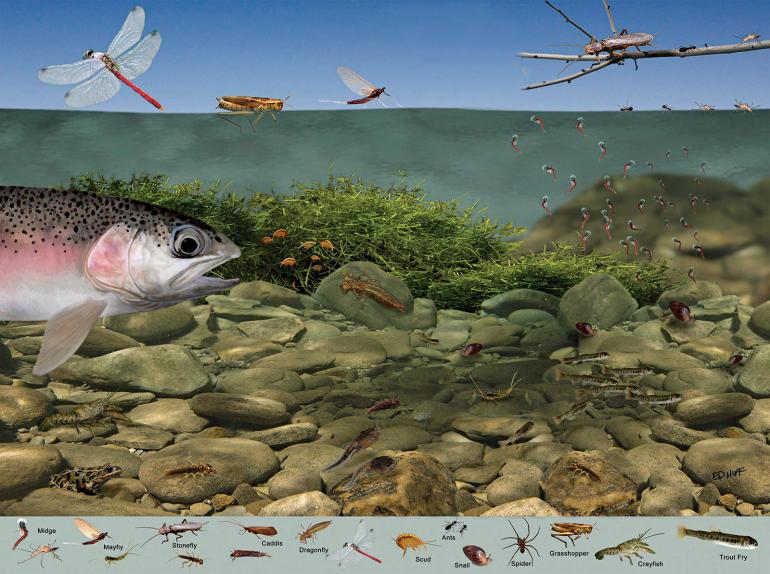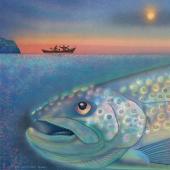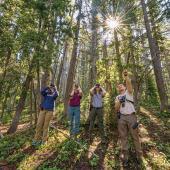A Trout's Diet
What's on the underwater menu.
Trout in streams occupy a space called a “holding lie.” This is a position in the stream that can give them protection from predators, access to food, or a combination of the two. The trout in this illustration has positioned itself in a prime holding lie where any animal unlucky enough to be swept up in the current could be carried into the path of this feeding trout. The prime positions (those that provide the best feeding opportunities or best protection) are occupied by the dominant trout. This hierarchy is maintained by threats and displays and rarely results in actual combat.
Aquatic Insects
Shown are only a few of the many aquatic insects that make up a part of a trout’s diet. For their own protection, some of these animals are difficult to see. There are five different species shown. These animals are members of a family called arthropods. Arthropoda means “jointed foot.” Over half of the animals on earth are arthropods. Insects, arachnids (spiders), and crustaceans are all arthropods. All insects have three body parts; a head, thorax and abdomen. They also have three pairs of legs, which are attached at the thorax. Aquatic insects spend the greater part of their lives in the water which makes them available to trout in their nymphal, larval, or pupal stages. As aquatic animals, they appear quite different in appearance when compared to their adult, terrestrial form. Shown are both the nymph or larval form, as well as the adult form. On a predetermined schedule, they emerge from the water and shed their outer covering and become adults. It is during the adult stage that they mate and lay eggs. During their emerging and egg-laying they become readily available to the trout as a food source.
Dragonfly Nymph – The dragonfly nymph is the aquatic stage of the dragonfly. A feeding trout will seldom pass up the opportunity to make a meal of a dragonfly nymph. The 42 species of dragonflies in California spend up to two years in the water before emerging as adults. As nymphs, dragonflies are predators themselves and are capable of catching and eating small fish.
Adult Dragonfly – These colorful insects spend only about two months as flying adults. Male and females often look like completely different species with widely contrasting colors. Adults are sometimes caught by trout as they skim over the water laying eggs or actually competing with the trout for other insects, which they both eat.
Caddisfly Larva – Many caddis flies create a protective case for themselves while in their larval stage. The case is comprised of small stones and sticks. This case provides both protection and camouflage.
Adult Caddisfly – When the mature caddis pupa swims or crawls to the surface, it sheds its pupal membrane and emerges as an adult. While the wings stiffen to prepare for flight, the caddis is particularly vulnerable to trout. When the fertilized female returns to deposit her eggs in the water, sometimes swimming or crawling underwater, she’s also exposed to feeding trout.
Mayfly Nymph – Mayflies also have both a nymphal stage and adult stage and are eagerly sought after by trout. They are one of the insects most often imitated by fly fishermen.
Adult Mayfly – The adults are very short lived, as they swim to the surface or crawl out of the water onto rocks or plants, making themselves vulnerable to trout. When the adult female returns to the water to lay eggs, she’s also available to trout. When they die a day or so after mating and egg-laying, the females, and sometimes the males, fall to the surface of the water as “spinners” and are taken by feeding trout.
Stonefly Nymph – The stonefly nymph is the aquatic stage of the stonefly. They are often swept loose from the rocks and are eagerly snapped up by feeding trout while they drift along.
Adult Stonefly – As stonefly nymphs near maturity, they move to the edge of the stream and crawl out on rocks or structures where they hatch into adults. After mating, the female deposits her eggs by either dropping them from just above the water surface, dipping the tip of her abdomen into the water, or crawling down rocks into the water, all of which exposes her to trout.
Midge Larva – The midge larva is the aquatic stage of a tiny insect called a chironomid. Midges are quite prolific; they hatch out in the millions and provide a good food source for trout. In streams, midges are often very tiny, but in lakes they are usually larger.
Adult Midge – This small, flying insect looks like a mosquito, but doesn’t bite. After swimming to the surface and hatching from the pupa stage, the adult midge sits on the water prior to becoming airborne and searching for a mate. It is during these swimming, hatching, and resting stages that it is available to trout, who sip them in by the hundreds.
Terrestrial Insects
Shown are only a few of the many terrestrial animals that are available to trout as a food source. Terrestrial animals are those which spend their lives above the water. Other examples might be bees, beetles, or butterflies. Terrestrial insects fall or are blown into the water from adjacent grasses, trees, or rocks.
Grasshoppers – These sometimes get blown by summer winds, or hop or fly accidentally into a stream or lake, where they become a big, tasty treat for trout.
Spiders – Although not insects, these arachnids sometimes find themselves on a trout’s menu. They often migrate by spinning a length of spider silk and drifting on air currents. Sometimes these migrations carry the spider out over water and into the path of a feeding trout.
Ants – Many types of ants undergo a flying stage and migrate in large swarms. These swarming ants are poor flyers and often find themselves in the water. Trout are quick to take advantage of these sources of food. Winds blowing up a mountain during spring or summer will often lift these light insects into the air, then deposit them on lakes or in mountain streams.
Mollusks – Mollusks are soft-bodied animals with an internal or external shell. The name of the phylum is derived from Latin word molluscus, meaning soft. Examples of mollusks are snails, clams, slugs, and octopus.
Snails – Snails are most available to trout as they drift in the surface film. They will generate a bubble of air inside their shells which buoys them to the surface where they are dispersed by the movement of current and wind. Drifting snails eat the algae and plankton that concentrate in the surface film.
Crustaceans – Members of the crustacean family are arthropods that have an exoskeleton which they need to molt (shed) in order to grow. Examples of crustaceans are crayfish, scuds, shrimp, and lobsters.
Scuds – Scuds are aquatic arthropods that spend their entire life in the water. They are distantly related to the common “pill bugs” often found in gardens.
Crayfish – Crayfish are a big meal for a hungry trout. These crustaceans are normally protected by a hard outer shell called an exoskeleton. They have to shed this hard exoskeleton periodically in order to grow. During the time it takes the new shell to harden they become easy prey for a hungry trout.
Amphibians – Most amphibians lay their eggs in water. When the young hatch they undergo a metamorphosis from juveniles with gills to adults that breathe air. Examples are frogs, toads, and salamanders.
Tadpoles – These aquatic animals are the larva of frogs. They are commonly called tadpoles or pollywogs. They have gills and tails to allow them to mature in an aquatic environment. Within one to two years they lose their tails, grow legs, and develop into frogs.
Frogs – The skin of the frog is permeable and very sensitive to any toxic substances in their water. In the spring, rising water signals frogs to lay their eggs which become millions of tadpoles—a trout feast.
Fish – Trout will consume any small fish they can catch, including their own young.
Trout Fry – Because they are carnivorous, adult trout are also sometimes cannibalistic, and will eat their own fry if they find them. The fry’s only defense is to hide among algae or structure in the stream. Adult trout will also eat eggs from other spawning trout which have been washed out of the spawning areas. These spawning areas are called redds.













